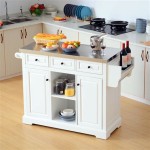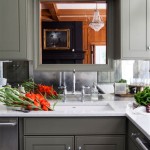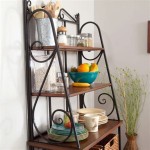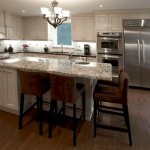Kitchen Island Table with Stools: A Functional and Stylish Addition
The kitchen island table with stools has emerged as a highly sought-after feature in modern kitchen designs. This adaptable furniture arrangement seamlessly merges functionality with aesthetics, offering a multitude of benefits for both small and large kitchens. It serves as a central hub for food preparation, dining, socializing, and even remote work. Understanding the versatility and design considerations involved in selecting a kitchen island table with stools is key to maximizing its potential within a home.
The primary allure of a kitchen island table with stools lies in its efficient utilization of space. In smaller kitchens, it can act as a dual-purpose surface – workstation during meal preparation and a dining area for casual meals. In larger kitchens, it can augment the existing countertop space while encouraging a convivial atmosphere. The stools contribute to accessibility, facilitating comfortable engagement with the island surface for various tasks.
Optimizing Kitchen Space and Functionality
One of the significant benefits of incorporating a kitchen island table with stools is its ability to optimize kitchen space. Traditional kitchens often feature segmented areas dedicated solely to food preparation or dining. The island table effectively blurs these lines, creating a unified space that enhances workflow and encourages interaction. This is especially crucial in open-plan living areas where the kitchen seamlessly integrates with the living and dining spaces.
The integration of storage solutions is another considerable advantage. Many kitchen island tables are designed with built-in cabinets, drawers, or open shelving. These features offer valuable storage space for cookware, utensils, small appliances, and even cookbooks. This helps declutter countertops and maintain a tidy kitchen environment. The placement of the storage is strategic, allowing for easy access to essential items during meal preparation.
Moreover, the placement of a kitchen island table influences the overall kitchen layout. It can be strategically positioned to create a working triangle between the sink, refrigerator, and cooktop, thereby improving efficiency during food preparation. It can also serve as a buffer zone between the cooking area and the dining or living space, preventing spills and splatters from reaching other areas of the home.
The height of the island table is a crucial factor to consider. Standard countertop height is generally around 36 inches, which is suitable for standing tasks like chopping vegetables and kneading dough. However, if the island also serves as a dining or workstation, a taller bar-height island (42 inches) or a lower table height (30 inches) might be more appropriate. The choice depends on the primary purpose of the island and the comfort of the users. Stools need to be selected accordingly, ensuring adequate legroom and comfortable seating height.
The addition of electrical outlets on the island is another practical consideration. Outlets provide convenient access to power for small appliances like blenders, food processors, and mixers. They can also be used to charge electronic devices like phones and tablets. Furthermore, incorporating a sink into the island allows for easier food preparation and cleanup. However, adding plumbing and electrical work will involve additional costs and require professional installation.
Design and Material Considerations
The aesthetic appeal of a kitchen island table with stools is just as important as its functionality. The design should complement the overall style of the kitchen and the surrounding areas. There is a wide range of design options available, from traditional farmhouse styles to sleek, modern designs. The materials used in the construction of the island and stools will significantly impact the overall look and feel of the kitchen.
For the island countertop, popular choices include granite, quartz, marble, butcher block, and stainless steel. Granite and quartz are durable, stain-resistant, and easy to maintain. Marble is a luxurious choice that adds elegance to the kitchen, but it is more susceptible to staining and scratching. Butcher block provides a warm, natural look and is ideal for food preparation, but it requires regular oiling and maintenance. Stainless steel is a hygienic and easy-to-clean option that is often used in professional kitchens. The selection of countertop material should be determined by the desired aesthetics, budget, and level of maintenance required.
The base of the island can be constructed from wood, metal, or a combination of both. Wood provides a classic and timeless look, while metal adds a modern and industrial touch. The finish of the base should complement the countertop and the surrounding cabinetry. The island's design should also consider the existing color palette of the kitchen to create a cohesive and harmonious look.
The selection of stools is equally important. Stools come in various styles, including bar stools, counter stools, and backless stools. Bar stools are typically taller than counter stools and are best suited for bar-height islands. Counter stools are shorter and are ideal for standard countertop height islands. Backless stools are more compact and can be easily tucked away when not in use. When selecting stools, comfort, durability, and style should be considered. The frame of the stools can be made from wood, metal, or plastic. The seat can be upholstered in fabric, leather, or vinyl. The material selection should depend on the desired comfort level, durability, and ease of cleaning.
The color and pattern of the stools can either complement or contrast with the island and the surrounding décor. Neutral colors like black, white, and gray are versatile and can easily blend with any kitchen style. Bold colors and patterns can add a pop of personality and create a focal point in the kitchen. However, it's important to ensure that the colors and patterns coordinate with the overall design scheme.
Enhancing Social Interaction and Entertainment
Beyond its functional benefits, a kitchen island table with stools fosters social interaction and enhances the entertainment capabilities of the kitchen. It creates a casual and inviting space where family and friends can gather while meals are being prepared. This encourages conversation and interaction, making the kitchen a more central and welcoming part of the home.
The island table can serve as a buffet during parties and gatherings. Food and drinks can be displayed on the countertop, allowing guests to easily serve themselves. The stools provide comfortable seating for guests to relax and socialize while enjoying refreshments. The island can also be used as a bar area, with stools providing seating for drinks and appetizers. This is particularly useful in open-plan living areas where the kitchen is integrated with the living and dining spaces.
For families with children, the kitchen island table with stools can serve as a homework station or a craft area. Children can sit at the island and work on their assignments while parents prepare meals. This allows parents to supervise their children while they are working and provides a convenient space for them to ask for help. The island can also be used for arts and crafts projects, providing a designated area for creative activities.
The presence of a kitchen island table can also enhance the resale value of a home. A well-designed and functional kitchen is a major selling point for potential buyers. The island adds visual appeal to the kitchen and creates a sense of spaciousness and functionality. This can make the home more attractive to buyers and increase its market value.
In summary, the kitchen island table with stools is a versatile and valuable addition to any kitchen. It optimizes space, enhances functionality, promotes social interaction, and increases the home's value. However, careful planning and consideration of design and material choices are essential to maximize its benefits and create a kitchen that is both functional and stylish. The height, materials, storage capacity, and overall aesthetic of the island and stools should be carefully considered to ensure they meet the needs and preferences of the homeowners. By integrating these elements effectively, a kitchen island table with stools can become the heart of the home, fostering a welcoming and functional space for years to come.

Tileon Cream White Kitchen Island Set W 2 Stools Rustic Wood Dining Table Prep With Open Shelf And Walnut Top Aybszhd294 The Home

Rustic Farmhouse Bar Island Table With 6 Barstools Etsy Kitchen

Island Hopping How The Kitchen Is Replacing Table Allthingshome Ca

Kitchen Island Table Ideas And Options Hgtv Pictures

Syngar Kitchen Island Set With 2 Stools Modern 3 Piece Dining Table Wood Top Person Bar Storage Shelves And Side For Breakfast Brown

Take A Seat At The New Kitchen Table Island

70 Best Kitchen Island Ideas For 2024

Kitchen Island Dining Table In Open Concept Living

Graystone Kitchen Island By Eci Furniture 3 Review S Furniturepick

Fufu Gaga White Oak Wood 59 1 In W Kitchen Island Dining Table With Adjustable Shelves And Drawer Kf210199 01 The Home








